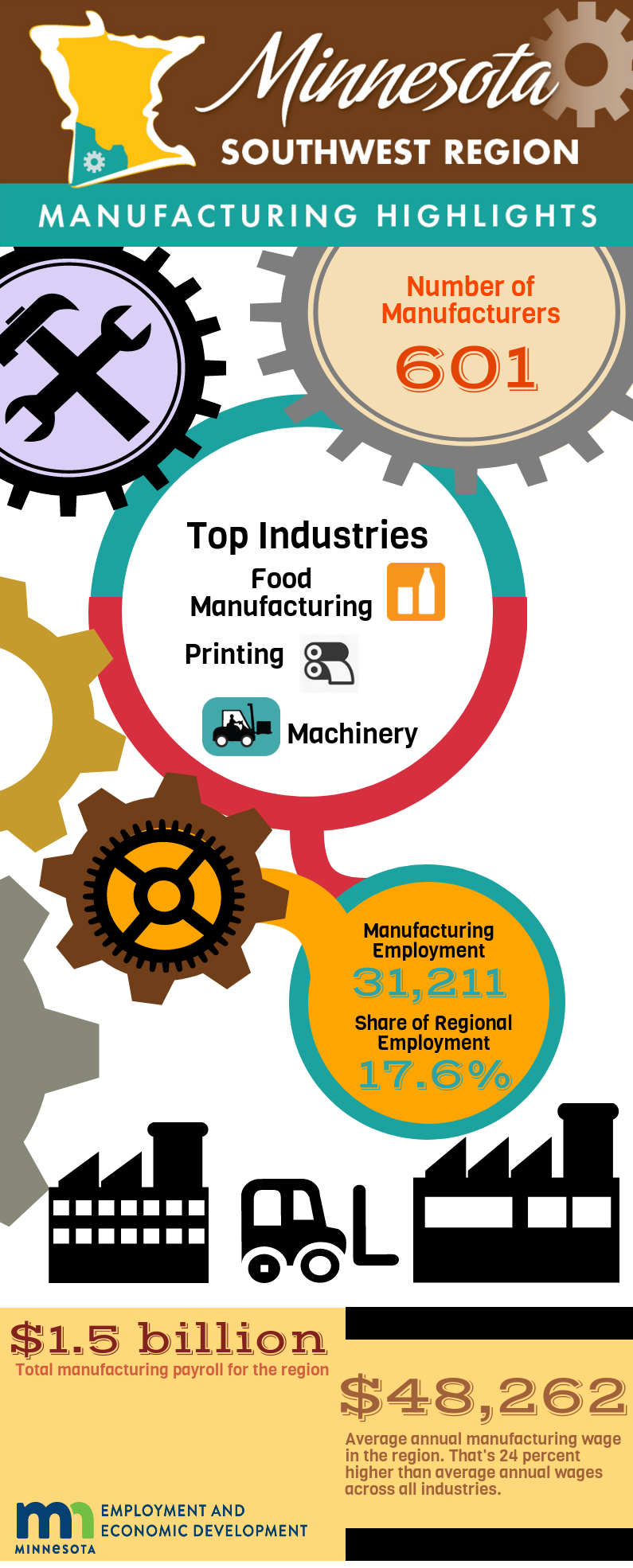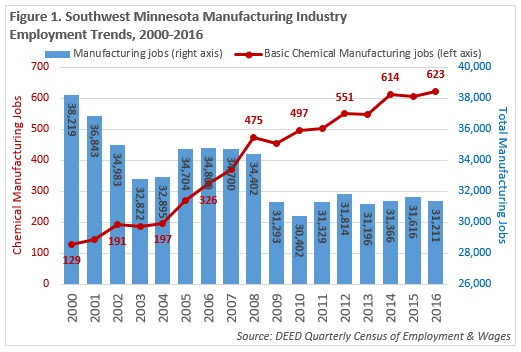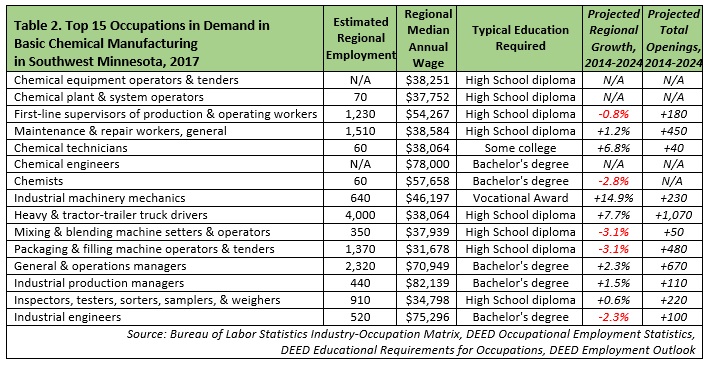 Southwest Minnesota is a national leader in agricultural production, and renewable energy.
Southwest Minnesota is a national leader in agricultural production, and renewable energy.
The region's thriving manufacturing sector includes food processing, machinery, printing, metal products, and computers and electronic products.
Want the freshest data delivered by email? Subscribe to our regional newsletters.
10/2/2017 10:09:32 AM
Luke Greiner
 With 31,211 jobs at 601 establishments, manufacturing is still the largest employing industry in the 23-county Southwest Minnesota region, just ahead of health care and social assistance. It is the only region in the state where manufacturing is still the leading industry. Manufacturing accounts for 17.6 percent of total employment in the Southwest region, making it over 6 percent more concentrated than in the state as a whole, where 11.3 percent of total jobs are in manufacturing.
With 31,211 jobs at 601 establishments, manufacturing is still the largest employing industry in the 23-county Southwest Minnesota region, just ahead of health care and social assistance. It is the only region in the state where manufacturing is still the leading industry. Manufacturing accounts for 17.6 percent of total employment in the Southwest region, making it over 6 percent more concentrated than in the state as a whole, where 11.3 percent of total jobs are in manufacturing.
After seeing steady job growth from 2010 to 2015, manufacturers in Southwest Minnesota sliced 405 jobs in the past year, a decline of 1.3 percent. However, the region still has about 800 more manufacturing jobs than it did in 2010, at the bottom of the recession.
With 10,474 jobs, the largest subsector in the Southwest region is food manufacturing, followed by printing and related support activities and machinery manufacturing, both of which had over 3,300 jobs. The region also had between 1,700 and 2,000 jobs apiece in fabricated metal product manufacturing; electrical equipment, appliance, and component manufacturing; computer and electronic product manufacturing; and nonmetallic mineral product manufacturing.
Southwest Minnesota has just over 6 percent of total employment in state, but nearly 23 percent of the state's jobs in food manufacturing and electrical equipment, appliance, and component manufacturing. The region also had location quotients above 2.5 in nonmetallic mineral product manufacturing and printing and related support activities, suggesting a regional competitive advantage in each of these areas as well.
Southwest Minnesota also shows higher concentrations of jobs in machinery manufacturing, primary metal manufacturing, beverage product manufacturing, transportation equipment manufacturing, wood product manufacturing, and chemical manufacturing. In fact, Southwest Minnesota has over 30 percent of the state's employment in agricultural machinery manufacturing and 44 percent of basic chemical manufacturing jobs, which includes ethanol and biodiesel plants.
One of the highest paying industries in the region, manufacturing payroll surpassed $1.5 billion in 2016, accounting for 22 percent of total payroll in Southwest Minnesota. Average annual wages in manufacturing were $48,262 in 2016, which was about $9,500 and 24 percent higher than average annual wages across the total of all industries. Manufacturing wages increased 1.9 percent over the past year, compared to a 1.6 percent wage increase overall from 2015 to 2016. However, manufacturing wages haven't grown as fast over the past five years, rising 15.4 percent from 2011 to 2016, just shy of the 16.6 percent growth rate across all industries.
As the only region in the state where manufacturing is still the largest employing industry, Southwest Minnesota has 31,211 manufacturing jobs – or about 10 percent of the state's total manufacturing jobs.
Chemical manufacturing was one of the smaller sectors in Southwest Minnesota, with less than 1,000 jobs total. However, the region stands out because it was home to 44 percent of the state's jobs in the basic chemical manufacturing subsector, which includes ethanol and biodiesel production. In Southwest, there were 15 establishments providing 623 jobs, with average wages above $62,000 per year, which was over $23,000 higher than annual wages across all industries (see Table 1).

In addition to high wages and a strong regional competitive advantage, basic chemical manufacturing offers something else extremely valuable to Southwest Minnesota – a steady stream of job growth in the face of manufacturing declines, especially in recessionary periods. The basic chemical manufacturing subsector reached a new employment peak in 2016, and has expanded 383 percent since 2000; in contrast to the manufacturing industry, which has declined 18 percent in the region over the past 16 years (see Figure 1).

That made basic chemical manufacturing the fastest growing manufacturing subsector in the region, expanding almost three times faster than the next closest subsector. And after gaining 494 net new jobs from 2000 to 2016, it was also the second largest growing subsector, behind only the much larger animal slaughtering and processing subsector – which has 4,940 jobs after adding 594 jobs.
Basic chemical manufacturing offers jobseekers a fast growing and high paying career opportunity, with a wide variety of jobs available. According to the industry-occupation matrix from the Bureau of Labor Statistics, eight of the top 15 occupations in demand in the industry can be gained with a high school diploma, yet they all pay over $30,000 per year at the median. In addition, five other careers in the top 15 require a bachelor's degree, with median annual wages ranging from over $57,000 to $82,000 per year (see Table 2).

Not surprisingly, five of the top seven occupations in demand have the word "chemical" in the title, including chemical equipment operators, chemical plant and system operators, chemical technicians, chemical engineers, and chemists. However, the fastest growing job was expected to be industrial machinery mechanics, but the industry also shows strong demand for heavy and tractor-trailer truck drivers.
The chemical manufacturing industry sector also benefits the region's farmers, providing an alternative outlet for crops like corn and soybeans. According to the Minnesota Bio-Fuels Association, Minnesota is currently the fourth largest ethanol producer in the United States. A past report from the Minnesota Department of Agriculture states that the "ethanol industry adds value to the state's largest agricultural crop – corn – by processing it into feed and fuel rather than it being sold just as a raw commodity."
A more recent study from ABF Economics used IMPLAN to show that the ethanol industry generated $7.6 billion in gross sales and supported 18,630 full time jobs in the state. Likewise, an economic impact analysis of biodiesel production from the Minnesota Department of Agriculture estimated a total output of $1.7 billion and employment impact of 5,397 jobs.
Contact Luke Greiner at 320-308-5378 or email luke.greiner@state.mn.us or Mark Schultz.